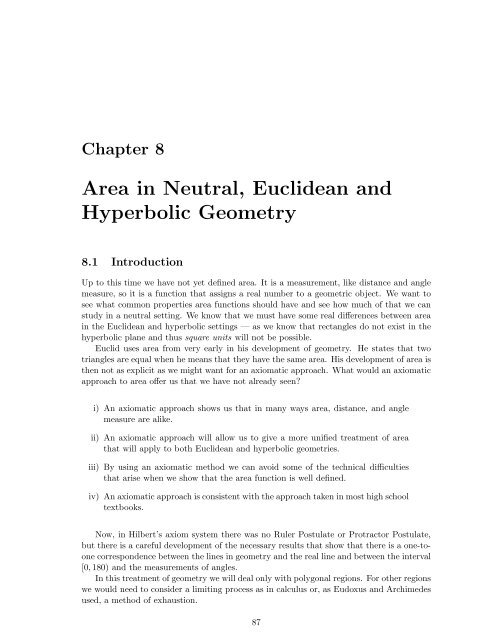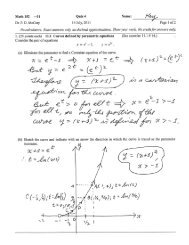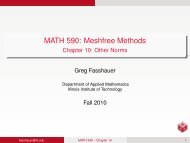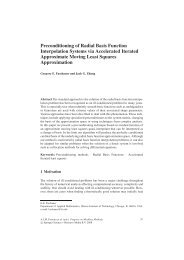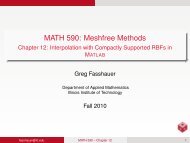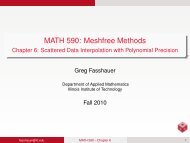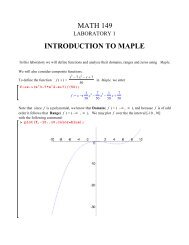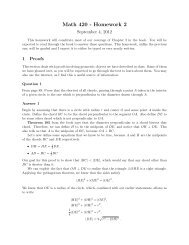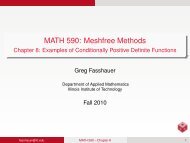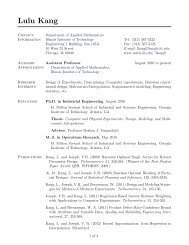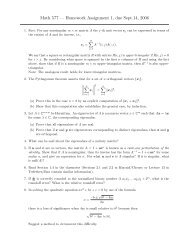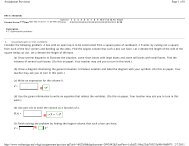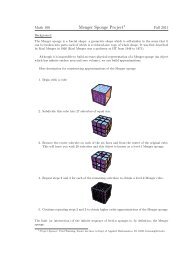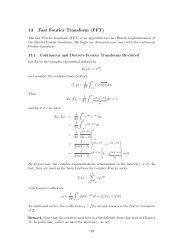Area in Neutral, Euclidean and Hyperbolic Geometry
Area in Neutral, Euclidean and Hyperbolic Geometry
Area in Neutral, Euclidean and Hyperbolic Geometry
You also want an ePaper? Increase the reach of your titles
YUMPU automatically turns print PDFs into web optimized ePapers that Google loves.
88CHAPTER 8. AREA IN NEUTRAL, EUCLIDEAN AND HYPERBOLIC GEOMETRY8.2 The <strong>Neutral</strong> <strong>Area</strong> PostulateWe need to def<strong>in</strong>e the region of which we want to f<strong>in</strong>d the area.Def<strong>in</strong>ition 8.1 Let △ABC be a triangle. The <strong>in</strong>terior of △ABC, denoted Int(△ABC), isthe <strong>in</strong>tersection of the <strong>in</strong>teriors of the three <strong>in</strong>terior angles ∠ABC, ∠BCA, <strong>and</strong> ∠CAB.Now, this gives us the po<strong>in</strong>ts <strong>in</strong>side the triangle, but not the po<strong>in</strong>ts on the triangle itself.Def<strong>in</strong>ition 8.2 Let △ABC be a triangle. The associated triangular region is the subset Tof the plane consist<strong>in</strong>g of all po<strong>in</strong>ts that lie on the triangle or <strong>in</strong> its <strong>in</strong>teriorT = △ABC ⋃ Int(△ABC) = ABC.Note that the triangle <strong>and</strong> the associated triangular region are not the same th<strong>in</strong>g. Atriangular region is the set of po<strong>in</strong>ts that <strong>in</strong>cludes not only the po<strong>in</strong>ts on the triangle itselfbut also the po<strong>in</strong>ts that lie <strong>in</strong>side the triangle. Intuitively a triangular region is a twodimensionalregion with positive area, while the triangle is a one-dimensional object thathas zero area - but does have length.A polygonal region is a plane figure which can be expressed as the union of a f<strong>in</strong>itenumber of triangular regions, <strong>in</strong> such a way that if two of the triangular regions <strong>in</strong>tersect,their <strong>in</strong>tersection is an edge or a vertex of each of them.Note that every triangular region is a polygonal region, but not vice versa.Let R be a polygonal region. A triangulation of R is a f<strong>in</strong>ite collection,of triangular regions T i , such thatK = {T 1 ,T 2 ,... ,T n }1. the T i ’s <strong>in</strong>tersect only at edges <strong>and</strong> vertices, <strong>and</strong>2. their union is R.Note that one polygonal region can have may different triangulations.Def<strong>in</strong>ition 8.3 Two polygonal regions R 1 <strong>and</strong> R 2 are nonoverlapp<strong>in</strong>g if R 1⋂R2 consistsonly of subsets of edges of each. Specifically, if T 1 is one of the triangular regions <strong>in</strong> R 1 <strong>and</strong>T 2 is one of the triangular regions <strong>in</strong> R 2 , then Int(T 1 ) ⋂ T 2 = ∅ <strong>and</strong> T 1⋂ Int(T2 ) = ∅.Axiom 7 (The <strong>Neutral</strong> <strong>Area</strong> Postulate) Associated with each polygonal region R thereis a positive number α(R), called the area of R, such that the follow<strong>in</strong>g conditions aresatisfiedi) (Congruence) If two triangles are congruent, then there associated triangularregions have equal areas.ii) (Additivity) If R − R 1⋃R2 is the union of two nonoverlapp<strong>in</strong>g polygonal regions,then α(R) = α(R 1 ) + α(R 2 ).Theorem 8.1 If △ABC is a triangle <strong>and</strong> E is a po<strong>in</strong>t on the <strong>in</strong>terior of AC, then ABC =ABE ∪ EBC. Furthermore, ABE <strong>and</strong> EBC are nonoverlapp<strong>in</strong>g regions.MATH 6118-090 Spr<strong>in</strong>g 2008
8.3. AREA IN EUCLIDEAN GEOMETRY 898.3 <strong>Area</strong> <strong>in</strong> <strong>Euclidean</strong> <strong>Geometry</strong>What choices do we have for area <strong>in</strong> <strong>Euclidean</strong> geometry? We have our usual choice forthe area of a rectangle, but is it uniquely determ<strong>in</strong>ed? For this section we will assume the<strong>Euclidean</strong> Parallel Postulate.For a rectangle □ABCD we know that □ABCD is convex <strong>and</strong> so the diagonals AC<strong>and</strong> BD <strong>in</strong>tersect <strong>in</strong> a po<strong>in</strong>t E. This then will allow us to associate a particular polygonalregion for each rectangle.Def<strong>in</strong>ition 8.4 Let □ABCD be a rectangle <strong>and</strong> let E be the po<strong>in</strong>t of <strong>in</strong>tersection of thediagonals. The rectangular region associated with □ABCD is the polygonal region R isR = ABE ∪ BCE ∪ CDE ∪ ADE.The length of R is AB <strong>and</strong> the width is BC.Axiom 8 (<strong>Euclidean</strong> <strong>Area</strong> Postulate) If R is a rectangular region, thenα(R) = length(R) × width(R).Now, it is easy to determ<strong>in</strong>e the area of a triangle.Theorem 8.2 If T is the triangular region correspond<strong>in</strong>g to the right triangle △ABC withright angle at C, then α(T) = 1 2(AC × BC).Def<strong>in</strong>ition 8.5 Let T be a triangular region correspond<strong>in</strong>g to △ABC. The base of T isAB. Drop a perpendicular from C to geol<strong>in</strong>eAB <strong>and</strong> call the foot of that perpendicular D.The height of T is the length of CD.Theorem 8.3 The area of a triangular region is one-half the length of the base times theheight; that is,α(T) = 1 base(T) × height(T).2Theorem 8.4 If two triangles are similar, then the ratio of their areas is the square ofthe ratio of the lengths of any two correspond<strong>in</strong>g sides; i.e., if △ABC ∼ △DEF <strong>and</strong>DE = k · AB, then α(△DEF) = k 2 · α(△ABC).8.4 F<strong>in</strong>ite DecompositionLet R 1 <strong>and</strong> R 2 be polygonal regions. Suppose that they have triangulationsK 1 = {T 1 ,T 2 ,... ,T n },K 2= {T ′ 1,T ′ 2,... ,T ′ n},such that for each i we have T i∼ = T′i . Then we say that R 1 <strong>and</strong> R 2 are equivalent by f<strong>in</strong>itedecomposition, <strong>and</strong> we write R 1 ≡ R 2 .The process of decompos<strong>in</strong>g a region <strong>in</strong>to triangles <strong>and</strong> reassembl<strong>in</strong>g them to form adifferent region is usually called dissection. The ma<strong>in</strong> problem is:Dissection Problem: Given two regions R <strong>and</strong> R′ with α(R) = α(R′), f<strong>in</strong>d triangulationsT <strong>and</strong> T ′ which show that R ≡ R′.MATH 6118-090 Spr<strong>in</strong>g 2008
¥££¢ ¥¢ ¡¢ ¤¢¥¢¥ £¤¢ £¢ ¡¢90CHAPTER 8. AREA IN NEUTRAL, EUCLIDEAN AND HYPERBOLIC GEOMETRYTheorem 8.5 (Fundamental Theorem of Decomposition Theory) If R <strong>and</strong> R′ aretwo polygonal regions such that α(R) = α(R′), then R ≡ R′.This seems to be obvious, but it is not as simple as it seems at first. Max Dehn proved<strong>in</strong> 1902 that it is not possible to cut a tetrahedron <strong>in</strong>to a f<strong>in</strong>ite number of polyhedral pieces<strong>and</strong> reassemble them to form a cube of equal volume. Thus, the analogous statement forthree-dimensions is not true.Theorem 8.6 Equivalence by f<strong>in</strong>ite decomposition is an equivalence relation:i) (Reflexive) R ≡ R for every polygonal region R.ii) (Symmetric) If R 1 ≡ R 2 , then R 2 ≡ R 1 .iii) (Transitive) If R 1 ≡ R 2 <strong>and</strong> R 2 ≡ R 3 , then R 1 ≡ R 3 .Proof: Reflexivity <strong>and</strong> symmetry are clear from the def<strong>in</strong>ition.Suppose that R 1 , R 2 <strong>and</strong> R 3 are polygonal regions such that R 1 ≡ R 2 <strong>and</strong> R 2 ≡ R 3 .We need to show that R 1 ≡ R 3 . Now the problem is that there may be different decompositionsthat give the equivalence of R 2 to R 1 <strong>and</strong> R 2 to R 3 . Say that the triangles <strong>in</strong> thedecomposition for the first equivalence are T 1 ,... ,T n <strong>and</strong> those for the second equivalenceare T 1 ′,... ,T m ′. In order to get one common subdivision for R 2 <strong>in</strong>to regions of the formT 1⋂Tj ′ where T i <strong>and</strong> T j ′ overlap. Each is either a triangle or a quadrilateral region. If itis the latter, we would decompose it <strong>in</strong>to triangles.The result is a subdivision of R 2 <strong>in</strong>to small triangles such that each small triangle T k ′′is conta<strong>in</strong>ed <strong>in</strong> both a T i <strong>and</strong> a T j ′. S<strong>in</strong>ce T k ′′ ⊂ T i there is a correspond<strong>in</strong>g congruentMATH 6118-090 Spr<strong>in</strong>g 2008
8.5. FINITE DECOMPOSITION IN EUCLIDEAN GEOMETRY 91triangle <strong>in</strong> R 1 . S<strong>in</strong>ce T k ′′ ⊂ T j ′ there is a correspond<strong>in</strong>g congruent triangle <strong>in</strong> R 2 . In thisway the triangles T k ′′ <strong>in</strong>duce triangulations of R 1 <strong>and</strong> R 3 that show R 1 ≡ R 3 .Given △ABC, with AB considered as the base. Let M <strong>and</strong> N be the midpo<strong>in</strong>ts of AC<strong>and</strong> BC, respectively. Let D, E, <strong>and</strong> F be the feet of the perpendiculars from B, A, <strong>and</strong>C, respectively, to l = DE. ←→As you will prove <strong>in</strong> the homework, □ABDE is a Saccheriquadrilateral. It is known as the quadrilateral associated with △ABC. It depends on thechoice of the base, but it should be clear which base we mean.C✛◗ ◗◗◗◗◗◗◗◗◗◗◗◗◗◗◗◗E MND✲F✁ ✁✁✁✁✁✁✁✁✁✁✁◗ ABFigure 8.1: The Saccheri quadrilateral associated with △ABCTheorem 8.7 Every triangular region is equivalent by f<strong>in</strong>ite decomposition to its associatedSaccheri quadrilateral region.Proof: We will look at the special case given <strong>in</strong> Figure 8.1. There are other cases thatshould be considered, but we will not undertake it here. Our special case is the situationwhere F lies between M <strong>and</strong> N. The more general case uses an <strong>in</strong>termediate parallelogram,but this case will give us a good feel<strong>in</strong>g for why this should be true.Let R be the quadrilateral region correspond<strong>in</strong>g to □ABNM, let T 1 = CMF, T 2 =CNF, T 1 ′ = AME, <strong>and</strong> T 2 ′ = BND. Then△ABC = R ⋃ T 1⋃T2 <strong>and</strong> □ABDE = R ⋃ T 1 ′ ⋃ T 2 ′.S<strong>in</strong>ce T 1∼ = T1 ′, <strong>and</strong> T 2∼ = T2 ′, it follows that △ABC ≡ □ABDE.Theorem 8.8 Let △ABC be a triangle <strong>and</strong> let □ABDE be its associated Saccheri quadrilateral.If H is a po<strong>in</strong>t so that AH crosses DE ←→at the midpo<strong>in</strong>t of AH, then □ABDE isalso the Saccheri quadrilateral associated with △ABH.8.5 F<strong>in</strong>ite Decomposition <strong>in</strong> <strong>Euclidean</strong> <strong>Geometry</strong>We will prove the Fundamental Theorem of Decomposition Theory (Theorem 8.5) <strong>in</strong> <strong>Euclidean</strong>geometry. We will do this <strong>in</strong> such a way that we might see a method to constructa similar proof <strong>in</strong> hyperbolic geometry. Aga<strong>in</strong>, we will assume the <strong>Euclidean</strong> Parallel Postulatefor this section.First, let’s restate the theorem.MATH 6118-090 Spr<strong>in</strong>g 2008
92CHAPTER 8. AREA IN NEUTRAL, EUCLIDEAN AND HYPERBOLIC GEOMETRYTheorem 8.5: [Fundamental Theorem of Decomposition Theory] If R <strong>and</strong> R′ aretwo polygonal regions such that α(R) = α(R′), then R ≡ R′.We will approach the proof of this <strong>in</strong> three steps.Step 1. Show that if △ABC <strong>and</strong> △DEF are two triangles such that α(△ABC) =α(△DEF) <strong>and</strong> AB ∼ = DE, then △ABC ≡ △DEF.Step 2. Use Step 1 to show that if △ABC <strong>and</strong> △DEF are any two triangles such thatα(△ABC) = α(△DEF), then △ABC ≡ △DEF.Step 3. Use Step 2 <strong>and</strong> an <strong>in</strong>ductive argument to show that if α(R 1 ) = α(R 2 ), thenR 1 ≡ R 2 .First we will restate Theorem 8.7 <strong>in</strong> <strong>Euclidean</strong> geometry, <strong>in</strong> which a Saccheri quadrilateralis a rectangle.Lemma 8.1 If △ABC is a triangle, then there are po<strong>in</strong>ts A′ <strong>and</strong> B′ such that □ABB′A′is a rectangle <strong>and</strong> △ABC ≡ □ABB′A′.We should then refer to □ABB′A′ as the associated rectangle.Lemma 8.2 IF □ABCD <strong>and</strong> □EFGH are two rectangles such that α(□ABCD) = α(□EFGH)<strong>and</strong> AB = EF, then □ABCD ∼ = □EFGH.Proof: We know that the area of the rectangle is the length times the height. S<strong>in</strong>ce thetriangles have the same area <strong>and</strong> the same length, they must have heights of equal length,so the rectangles are congruent.Now, we can prove Step 1.Theorem 8.9 If △ABC <strong>and</strong> △DEF are two triangles such that α(△ABC) = α(△DEF)<strong>and</strong> AB = DE, then △ABC ≡ △DEF.Proof: Let △ABC <strong>and</strong> △DEF be two triangles such that α(△ABC) = α(△DEF) <strong>and</strong>AB = DE. Suppose that □ABB′A′ <strong>and</strong> □DEE′D′ are the associated rectangles to thetwo triangles. S<strong>in</strong>ce these two rectangles have the same area <strong>and</strong> congruent bases, by theabove lemma, they are congruent. Thus, △ABC ≡ □ABB′A′ ∼ = □DEE′D′ ≡ △DEF,<strong>and</strong> the theorem follows by the transitivity of equivalence.Now, for Step 2 we have the follow<strong>in</strong>g theorem.Theorem 8.10 If △ABC <strong>and</strong> △DEF are any two triangles such that α(△ABC) = α(△DEF),then △ABC ≡ △DEF.Proof: Let △ABC <strong>and</strong> △DEF be two triangles such that α(△ABC) = α(△DEF). Wemay assume that if correspond<strong>in</strong>g sides are congruent, then the triangles are congruent <strong>and</strong>we are done. Thus, we may assume that DF ≥ AC. Let M bet the midpo<strong>in</strong>t of AC <strong>and</strong>let N be the midpo<strong>in</strong>t of BC.Now AM ≤ 1 −−→2DF <strong>and</strong> there are po<strong>in</strong>ts P ∈ MN so that MP > 1 2DF. Now, there isa po<strong>in</strong>t G ∈ −−→ MN such that AG = 1 −→2DF. Choose a po<strong>in</strong>t H ∈ AG so that GH ∼ = AG. ByTheorem 8.8 △ABC <strong>and</strong> △ABH share the same associated rectangle, so △ABC ≡ △ABH.Furthermore, AH = DF so that △ABH ≡ △DEF. Therefore, △ABC ≡ △DEF.MATH 6118-090 Spr<strong>in</strong>g 2008
8.6. AREA IN HYPERBOLIC GEOMETRY 93To complete this proof <strong>in</strong> Step 3 we need one more fact about the areas of <strong>Euclidean</strong>triangles.§ ¨© ¦Lemma 8.3 If △ABC is a triangle <strong>and</strong> a ∈ R so that 0 < a < α(△ABC), then thereexists a po<strong>in</strong>t D ∈ AB so that α(△ADC) = a.Proof: Use the Ruler Postulate to choose a po<strong>in</strong>t D ∈ AB such thatAD =aα(△ADC) AB.S<strong>in</strong>ce △ABC <strong>and</strong> △ADC share the same height, if follows that α(△ADC) = a.F<strong>in</strong>ally, we can f<strong>in</strong>ish the Fundamental Theorem of Decomposition Theory.Theorem 8.11 If R <strong>and</strong> R′ are two polygonal regions such that α(R) = α(R′), then R ≡R′.Proof: Let R <strong>and</strong> R′ be two polygonal regions such that α(R) = α(R′). Choose triangulationsT 1 ,... ,T n <strong>and</strong> T 1 ′,...,T m ′ of R <strong>and</strong> R′, respectively.Consider two triangles T 1 <strong>and</strong> T 1 ′. We may assume that T 1 has the smaller area.If it should happen that α(T 1 ) = α(T 1 ′), then delete T 1 from R <strong>and</strong> T 1 ′ from R′. Ifα(T 1 ) ≠ α(T 1 ′), then α(T 1 ) < α(T 1 ′). By the above lemma, T 1 ′ can be subdivided <strong>in</strong>to twotriangles T ′′1<strong>and</strong> T′′′1 such that α(T′′1 ) = α(T 1). Delete T 1 from R <strong>and</strong> delete T ′′The result of this operation is a new pair of polygonal regions R 1 <strong>and</strong> R 1 ′1 from R′ .. Now thedeleted triangles have the same area, we know that α(R 1 ) = α(R 1 ′ ). If we could prove thatR 1 ≡ R 1 ′ , then it would follow that R ≡ R′ because T 1 ≡ T 1 ′′.Now the new regions R 1 <strong>and</strong> R 1 ′ have smaller areas than the orig<strong>in</strong>als <strong>and</strong> the totalnumber of triangles <strong>in</strong> the two triangulations has been reduced. The number is reducedby 2 <strong>in</strong> the first case <strong>and</strong> by 1 <strong>in</strong> the second case. We apply the previous process a f<strong>in</strong>itenumber of times <strong>and</strong> we reduce to regions that are triangular. Then apply Theorem 8.10 tothose triangular regions. Then you can the triangles back <strong>in</strong> <strong>and</strong> apply Theorem 8.10 eachtime to give the equivalence between the orig<strong>in</strong>al regions.8.6 <strong>Area</strong> <strong>in</strong> <strong>Hyperbolic</strong> <strong>Geometry</strong>We want to follow the above outl<strong>in</strong>e to study the concept of area <strong>in</strong> hyperbolic geometry.We need to look for an analogous result to Theorem 8.9. We don’t have that type oftheorem, but what we do have is that from Theorem 7.5 if two Saccheri quadrilaterals haveMATH 6118-090 Spr<strong>in</strong>g 2008
94CHAPTER 8. AREA IN NEUTRAL, EUCLIDEAN AND HYPERBOLIC GEOMETRYthe same defect <strong>and</strong> same summit, then they are congruent. This will lead down a path tounderst<strong>and</strong><strong>in</strong>g area <strong>in</strong> the hyperbolic plane. It says that somehow area <strong>and</strong> defect will berelated.Let δT = defect (△(T)) for any triangular region T. What will be prove is the follow<strong>in</strong>gtheorem due to Janos Bolyai.Theorem 8.12 (Bolyai’s Theorem for the <strong>Hyperbolic</strong> Plane) If T 1 <strong>and</strong> T 2 are triangularregions, <strong>and</strong> δT 1 = δT 2 , then T 1 ≡ T 2 .NOTE: Defect applies to triangles <strong>and</strong> quadrilaterals while area applies to triangular regions<strong>and</strong> polygonal regions. We will not make such a strict del<strong>in</strong>eation of the terms <strong>and</strong> will talkabout the defect of a triangular region, know<strong>in</strong>g that it means the defect of the associatedtriangle.Lemma 8.4 If K 1 <strong>and</strong> K 2 are triangulations of the same polygonal region R, then δK 1 =δK 2 .Lemma 8.5 Every triangular region has the same defect as its associated Saccheri quadrilateralregion.Lemma 8.6 If △ABC <strong>and</strong> △DEF have the same defect <strong>and</strong> a pair of congruent sides,then the two triangular regions are equivalent by f<strong>in</strong>ite decomposition.Proof: Assume that δ(△ABC) = δ(△DEF) <strong>and</strong> that AB ∼ = DE. Let □ABB ′ A ′ <strong>and</strong>DEE ′ D ′ be the associated Saccheri quadrilaterals correspond<strong>in</strong>g to △ABC <strong>and</strong> △DEF,respectively. By the above lemma δ(□ABB ′ A ′ ) = δ(□DEE ′ D ′ ). S<strong>in</strong>ce AB is the summitof ABB ′ A ′ <strong>and</strong> DE is the summit of DEE ′ D ′ <strong>and</strong> AB ∼ = DE, by Theorem 7.5 we havethat □ABB ′ A ′ ∼ = □DEE ′ D ′ . By the transitivity of equivalence <strong>and</strong> our previous result, weare done.Proof of Bolyai’s Theorem: This is not that much different from the proof of Theorem8.10.Let △ABC <strong>and</strong> △DEF be two triangles such that δ(△ABC) = δ(△DEF). We mayassume that if correspond<strong>in</strong>g sides are congruent, then the triangles are congruent <strong>and</strong> weare done. Thus, we may assume that DF ≥ AC. Let M bet the midpo<strong>in</strong>t of AC <strong>and</strong> let Nbe the midpo<strong>in</strong>t of BC.Choose a po<strong>in</strong>t G ∈ MN ←→such that AG = 1 2<strong>and</strong> GH ∼ = AG. By Theorem 8.8 △ABC <strong>and</strong> △ABH share the same associated Saccheriquadrilateral, so △ABC ≡ △ABH. Furthermore, AH = DF so that △ABH ≡ △DEF.Therefore, △ABC ≡ △DEF.This leads us to the follow<strong>in</strong>g result <strong>in</strong> H 2 . It says that <strong>in</strong> hyperbolic geometry defect<strong>and</strong> area are essentially the same. Why should we have expected this? Well, we should nothave expected it at all. Their def<strong>in</strong>itions do not lead us to believe that this might be thecase.DF. Choose a po<strong>in</strong>t H ∈−→AG so that A∗G∗HTheorem 8.13 (<strong>Area</strong> <strong>and</strong> Defect Theorem) There exists a constant k such thatα(△ABC) = k · δ(△ABC)for every triangle △ABC <strong>in</strong> the hyperbolic plane.MATH 6118-090 Spr<strong>in</strong>g 2008
8.6. AREA IN HYPERBOLIC GEOMETRY 95To prove this we need a few prelim<strong>in</strong>ary results. First though, a couple of corollaries:Corollary 1 There is an upper bound on the areas of triangles.Corollary 2 Let △ABC <strong>and</strong> △DEF be two triangles. If α(△ABC) = α(△DEF), then△ABC ≡ △DEF.Now, for the prelim<strong>in</strong>aries for the proof of Theorem ??.Lemma 8.7 For any two triangles △ABC <strong>and</strong> △DEF,α(△ABC)δ(△ABC) = α(△DEF)δ(△DEF) .Proof: First, consider the case when δ(△ABC) = δ(△DEF). Then, by Bolyai’s Theorem,△ABC ≡ △DEF, so α(△ABC) = α(△DEF), <strong>and</strong> the lemma holds.Now, consider the case <strong>in</strong> which δ(△ABC)/δ(△DEF) is a rational number, so thatδ(△ABC)δ(△DEF) = p q ,where both p <strong>and</strong> q are positive <strong>in</strong>tegers <strong>and</strong> p < q. S<strong>in</strong>ce defect is a cont<strong>in</strong>uous function,there are po<strong>in</strong>ts P 0 ,P 1 ,...,P q on DE so that D = P 0 , P i−1 ∗ P i ∗ P i+1 for all i, P q = E <strong>and</strong>δ(△FP i P i+1 ) = 1 q δ(△DEF)for each i.Note that by the Additivity of the Defect δ(△ABC) = δ(△FP 0 P p ). By our work at thebeg<strong>in</strong>n<strong>in</strong>g of the proof, all of the small triangles △FP i P i+1 have the same area. Therefore,by the Additivity of the Defect <strong>and</strong> the Additivity of the <strong>Area</strong>, we are done.To show this for any real number, we rely on the properties of the real numbers stated<strong>in</strong> the follow<strong>in</strong>g two theorems, <strong>and</strong> we are done.Theorem 8.14 If a <strong>and</strong> b are real numbers such that a < b, then there exists a rationalnumber x such that a < x < b <strong>and</strong> there exists an irrational number y so that a < y < b.Theorem 8.15 IF x <strong>and</strong> y are real numbers such thati) every rational number that is less than x is less than y, <strong>and</strong>ii) every rational number that is less than y is also less than x,then x − y.Now, we are <strong>in</strong> a position to prove Theorem ??.Proof: Fix one triangle △DEF <strong>and</strong> letBy the above lemma,k = α(△DEF)δ(△DEF) .α(△ABC)δ(△ABC) = kfor every triangle △ABC <strong>and</strong> so α(△ABC) = kδ△ABC) for every △ABC.MATH 6118-090 Spr<strong>in</strong>g 2008
96CHAPTER 8. AREA IN NEUTRAL, EUCLIDEAN AND HYPERBOLIC GEOMETRYNote that we have not yet def<strong>in</strong>ed an area function for the hyperbolic plane. The easiestway to do so would be to take k = 1 thus mak<strong>in</strong>g α(△ABC) = δ(△ABC). This is notalways what we want to do though. We will see <strong>in</strong>dications of why as we move through thecourse.We can now complete the proof of the Fundamental Theorem of Decomposition Theory<strong>in</strong> the hyperbolic plane. The proof is done much as it was <strong>in</strong> the <strong>Euclidean</strong> case, so add<strong>in</strong>ga proof here will not add anyth<strong>in</strong>g new.Instead, let us look at one more bit of <strong>in</strong>formation about the area. Why did we notdef<strong>in</strong>e the area for the hyperbolic plane much as we did for the <strong>Euclidean</strong> plane? We cannotdef<strong>in</strong>e the area <strong>in</strong> terms of rectangles, but most assuredly we could have def<strong>in</strong>ed the area ofa triangle us<strong>in</strong>g the same formula as we did <strong>in</strong> the <strong>Euclidean</strong> plane. Isn’t true thatActually, no! We need to see why.<strong>Area</strong> = 1 base × height?28.7 The <strong>Hyperbolic</strong> <strong>Area</strong> FunctionTheorem 8.16 If δ△ABC > δ△DEF, then there is a po<strong>in</strong>t P between A <strong>and</strong> C such thatδ△ABP = δ△DEF.Now, how do we def<strong>in</strong>e the area of a polygonal region <strong>in</strong> the hyperbolic plane? Shouldwe def<strong>in</strong>e the area <strong>in</strong> the same way that we do <strong>in</strong> the <strong>Euclidean</strong> plane? If so, what are them<strong>in</strong>imum requirements for an area function of the <strong>Euclidean</strong> plane? M<strong>in</strong>imally it shouldsatisfy the follow<strong>in</strong>g: Let R be the set of all polygonal regions <strong>in</strong> H 2 . An area functionshould be a functionα : R → Rsuch that1. αR > 0 for every R;2. if R 1 <strong>and</strong> R 2 <strong>in</strong>tersect only <strong>in</strong> edges <strong>and</strong> vertices, thenα(R 1 ∪ R 2 ) = αR 1 + αR 2 ;3. if T 1 <strong>and</strong> T 2 are triangular regions with the same base <strong>and</strong> altitude, then αT 1 = αT 2 .If there is such a function α, then by (2) <strong>and</strong> (3) it will satisfy4. if R 1 ≡ R 2 , then αR 1 = αR 2 , because congruent triangles have the same bases <strong>and</strong>altitudes.In <strong>Euclidean</strong> geometry we can show that this area function is unique <strong>and</strong> it must satisfythe formula αT = 1 2bh for each triangular region, T, where b is the length of the base <strong>and</strong>h is the length of the altitude.Theorem 8.17 There is no such function α : R → R satisfy<strong>in</strong>g (1), (2), (3), <strong>and</strong>, hence,(4).MATH 6118-090 Spr<strong>in</strong>g 2008
98CHAPTER 8. AREA IN NEUTRAL, EUCLIDEAN AND HYPERBOLIC GEOMETRYTherefore by Bolyai’s Theorem the regions T <strong>and</strong> T n determ<strong>in</strong>ed by these triangles areequivalent by f<strong>in</strong>ite decomposition. By condition (4) this means that αT = αT n . ButαT n = αT 1 = A.Therefore,Because α△ABP 1 > 0 <strong>and</strong>this must be impossible.αT = αT 1 .αT 1 = αT + α△ABP 1 .Note that we have proven the follow<strong>in</strong>g result.Theorem 8.18 There exist triangles <strong>in</strong> H 2 that have the same base <strong>and</strong> height but differentareas.8.8 The Uniqueness of <strong>Hyperbolic</strong> <strong>Area</strong> TheoryAny reasonable area function α should have the follow<strong>in</strong>g properties:1. αR > 0 for every R;2. if R 1 <strong>and</strong> R 2 <strong>in</strong>tersect only <strong>in</strong> edges <strong>and</strong> vertices, then3. if R 1 ≡ R 2 , then αR 1 = αR 2 .α(R 1 ∪ R 2 ) = αR 1 + αR 2 ;We normally replace the <strong>Area</strong>-Defect Theorem result with the follow<strong>in</strong>g constant:Theorem 8.19 There is a positive constant k > 0 such thatfor every triangle.This changes our earlier result toα(△ABC) = π180 k2 δ(△ABC)Corollary 3 In H 2 the area of any triangle is at most πk 2 .There is no f<strong>in</strong>ite triangle whose area equals the maximal value πk 2 , although you canapproach this area as closely as you wish (<strong>and</strong> achieve it with a trebly asymptotic triangle).J. Bolyai proved that you can construct a circle of area πk 2 <strong>and</strong> a regular 4-sided polygonwith a 45 ◦ angle that also has this area.MATH 6118-090 Spr<strong>in</strong>g 2008


